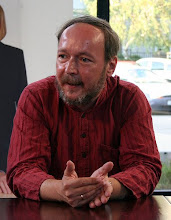
It would be hard to deny that current user/survivor advocacy has been very much shaped by the American (or Anglo-Saxon?) advocacy traditions. This approach has resulted in a number of achievements, we, user/survivor advocates can rightly be proud of. But certainly this approach has its limits. It looks like the American/Anglo-Saxon way reached its limits. After decades of advocacy we are not much closer in eradicating force from psychiatry. Some of my colleagues, especially from the States expect significant changes from the UN Convention on the Rights of Persons with Disabilities. It is a shame that it is most unlikely that the US will sign, let alone ratify CRPD in the foreseeable future. My position is that CRPD is a good basis but only if we can innovate our advocacy philosophy.

Martin Luther King went to India to learn from their tradition before launched their civil rights movement. Can we also learn something timely from the Indian tradition? After three months in India and after numerous discussios on Gandhi and the Freedom fight with Amita and many colleagues, and after reading on the topic and from the leaders of the Indian freedom fight, my proposal is that yes, we can learn a number of timely lessons that may help utilize the opportunity brought by the entry into force of the CRPD.
I state that Gandhi's most important advocacy principle was not the principle of non-violence, as many of us believe. While non-violence has been enormously (and for the West most unexpectedly) powerful, the Gandhi follower Mandela, who emphasised the superior value of non-violence, had resumed to violence on occasions. This was not in contradiction with Gandhi himself, as he had written: "'that where there is only a choice between cowardice and violence, I would advise violence". Simlarly, I am advocating for non-violent user/survivor advocacy, but together with Gandhiji's precaution. I think Gandhi's major advocacy innovation was that he was able to present the concepts of freedom and liberty in a language and historical context that was natural and easy to understand for Indians. Through presenting these ideals and goals as inherently Indian ones he managed to convince masses to follow the route and adopt also the non-violence principle.
What this may mean for our current day user/survivor advocacy is that we need to learn how to present CRPD in the language and historical context of the user/survivor culture. So far most of the advocacy efforts have started from CRPD and explain what it means for users/survivors. What the Gandhiji tradition tells me is that we need to follow the opposite way: let us go back to the user/survivor culture and link the values discoursed there with the CRPD. Then we can mobilise much more users/survivors than following the "let us translate CRPD to user/survivor language" approach.

Another proposal I am making based on my lessons in the Indian tradition is that we both need to mobilise our peers to become their own advocates, as the father of the Constitution of India, dr Ambedkar did with the dalits AND to change the hearts of the majority society, as Gandhiji did with caste Hindus. Self-gettoing is an ever-present danger in any marginalised groups advocacy movement, and this twin-track approach can help us prevent it.
Sources for the photos:
- Gandhi: http://www.khaasbaat.com/may2007/images/may07/gandhi.jpg
- King: Library of Congress. New York World-Telegram & Sun Collection. http://hdl.loc.gov/loc.pnp/cph.3c26559 Date=1964 Author=Dick DeMarsico, World Telegram staff photog
- Ambedkar: http://www.unm.edu/~rhayes/ambedkar.jpeg

1 comment:
this is a truly powerful and relevant statement, and on many levels - for me, particularly so as it points to the relevance of interplay between language, history, self-awareness and community connections. These are frequently 'corrupted' in the present day, globalising, context. The latest 'global initiative' published in Lancet is a very good example of that, at least for me.
Post a Comment